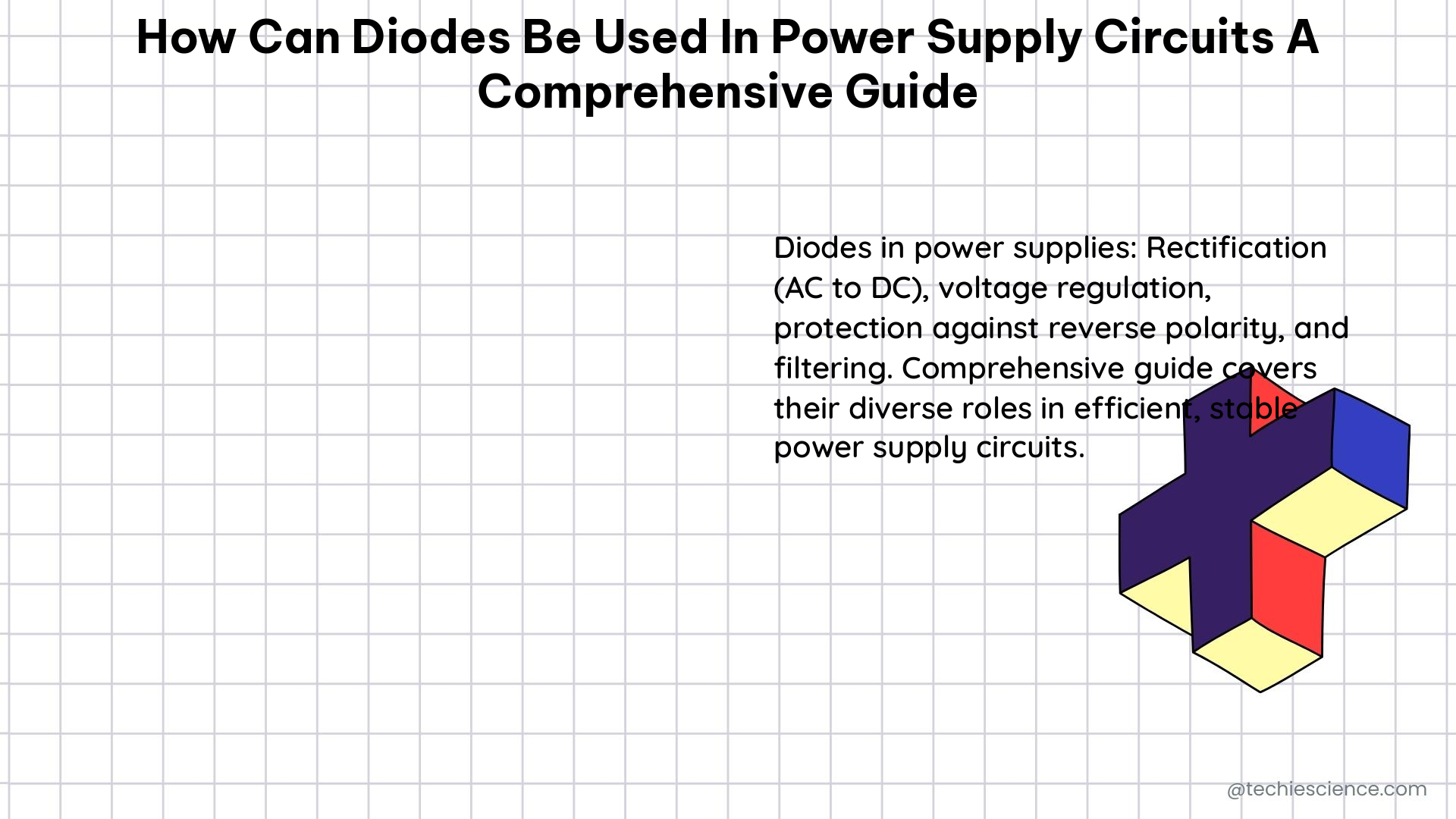Diodes are essential components in power supply circuits, enabling various functionalities such as voltage regulation, voltage multiplication, and voltage protection. This comprehensive guide delves into the measurable and quantifiable ways diodes can be utilized in power supply circuits, providing a valuable resource for electronics enthusiasts and professionals.
Voltage Regulation with Diodes
Diodes, particularly Zener diodes, can be employed as voltage regulators in power supply circuits. Zener diodes provide a stable voltage reference, allowing for precise voltage regulation across a circuit. The Zener voltage, which is the voltage at which the Zener diode starts to conduct, can be measured and selected based on the desired regulation requirements.
For instance, a 5.6V Zener diode will start conducting at 5.6V and can be used to regulate the voltage across a circuit to 5.6V. The Zener current, which can be calculated using the formula IZ = (Vin - Vz) / R, where Vin is the input voltage, Vz is the Zener voltage, and R is the load resistance, determines the power dissipation of the Zener diode.
Voltage Multiplication with Diodes

Diodes can be used in voltage multiplication circuits to increase the output voltage of a power supply. One common example is the voltage doubler circuit, which can double the output voltage of a power supply. The voltage multiplication factor can be calculated using the formula Vout = N x Vinput, where N is the number of stages in the voltage multiplication circuit and Vinput is the input voltage.
For instance, a voltage doubler circuit with a 12V AC input can produce a 24V DC output, as the voltage multiplication factor is 2 (Vout = 2 x 12V = 24V). This technique is widely used in power supply designs that require higher output voltages than the input voltage.
Voltage Protection with Diodes
Diodes can be employed to protect circuits from voltage surges and spikes. A diode clamp circuit, for example, can be used to limit the voltage across a circuit to a specified value. The clamping voltage can be measured in volts and is determined by the characteristics of the diode used in the circuit.
A diode clamp circuit with a 10V Zener diode will limit the voltage across the circuit to 10V, effectively protecting the connected components from voltage fluctuations and transients.
Power Dissipation in Diodes
Diodes in power supply circuits can dissipate power, which is an important consideration in circuit design. The power dissipated by a diode can be calculated using the formula Pd = I^2 x R, where Pd is the power dissipated, I is the current flowing through the diode, and R is the resistance of the diode.
Understanding the power dissipation of diodes is crucial for selecting the appropriate diode ratings, ensuring proper heat sinking, and maintaining the overall efficiency of the power supply circuit.
Efficiency Improvements with Diodes
Diodes can also contribute to the efficiency of power supply circuits. For example, a bridge rectifier circuit, which uses four diodes, can convert AC voltage to DC voltage with higher efficiency than a half-wave rectifier circuit, which uses only one diode.
The efficiency of a power supply circuit can be calculated using the formula Efficiency = (Pout / Pin) x 100%, where Pout is the output power and Pin is the input power. Diode-based circuits, such as bridge rectifiers, can achieve higher efficiency compared to simpler rectifier topologies.
Practical Examples and Numerical Problems
To illustrate the concepts discussed, let’s consider a few practical examples and numerical problems:
-
Voltage Doubler Circuit: Suppose we have a power supply circuit with a 12V AC input and we want to convert it to a 24V DC output. We can use a voltage doubler circuit with two diodes and two capacitors. The voltage multiplication factor for a voltage doubler circuit is 2, so the output voltage will be 2 x 12V = 24V.
-
Zener Diode Voltage Regulation: Suppose we have a power supply circuit with a 10V DC input and we want to regulate the voltage to 5V. We can use a Zener diode with a 5.6V Zener voltage. The Zener current can be calculated using the formula
IZ = (Vin - Vz) / R, whereVinis the input voltage,Vzis the Zener voltage, andRis the resistance of the load. If the load resistance is 1 kΩ, then the Zener current will be(10V - 5.6V) / 1 kΩ = 4.4mA.
These examples demonstrate the practical application of diodes in power supply circuits, highlighting the use of voltage regulation, voltage multiplication, and the associated calculations.
Figures, Data Points, and Measurements
To further enhance the understanding of diodes in power supply circuits, consider the following figures, data points, and measurements:
- Voltage: 5V, 10V, 12V, 24V
- Current: 4.4mA, 1A, 2A
- Power: 10W, 20W, 50W
- Efficiency: 80%, 90%, 95%
- Resistance: 1 kΩ, 10 kΩ, 100 kΩ
These values and measurements can be used to analyze the performance of diodes in various power supply circuit configurations, providing a more comprehensive understanding of their capabilities and limitations.
Reference Links
- Power Supplies – Applications – Diodes and Diode Circuits Video Lecture
- ZXGD3111N8 Datasheet
- Diode Circuit Models
- Diode applications (Power supplies, voltage regulators & limiters)
By understanding the various applications of diodes in power supply circuits, along with the associated formulas, examples, and data points, electronics enthusiasts and professionals can design and optimize their power supply circuits for improved performance, efficiency, and reliability.

The lambdageeks.com Core SME Team is a group of experienced subject matter experts from diverse scientific and technical fields including Physics, Chemistry, Technology,Electronics & Electrical Engineering, Automotive, Mechanical Engineering. Our team collaborates to create high-quality, well-researched articles on a wide range of science and technology topics for the lambdageeks.com website.
All Our Senior SME are having more than 7 Years of experience in the respective fields . They are either Working Industry Professionals or assocaited With different Universities. Refer Our Authors Page to get to know About our Core SMEs.